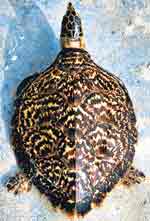|
By
Kumudini Hettiarachchi
Rekawa,
beyond Tangalle way down south, earlier notorious for its trade
in turtles, both live creatures and eggs, is set to be placed on
Sri Lanka’s map as the first wildlife sanctuary to be declared
for reptiles.
“This will be the first sanctuary in the country dedicated
to reptiles along with Godawaya a little distance away,” said
Deputy Director Vasantha Rathnayake who handles ‘Protected
area development and management’ at the Department of Wildlife
Conservation.
The papers with the declaration under the Fauna and Flora Protection
Ordinance have been sent to Environment Minister Maithripala Sirisena
for signature, he said, adding that it is appropriate in this Year
of the Turtle that Sri Lanka strengthen its protection mechanisms
for turtles which are an endangered species. “In March, the
department in association with IUCN, the World Conservation Union,
issued the ‘Marine Turtle Conservation Strategy and Action
Plan of Sri Lanka.”
Of the seven species of marine turtles found in the world, five
visit Rekawa regularly. The environment of Rekawa, with its mangroves,
long stretch of beach and coral reefs is the ideal lure for the
Green turtle, the Olive Ridley turtle, the Leatherback turtle, the
Loggerhead turtle and the Hawksbill turtle. The other two species
– Flatback and Kemp’s Ridley – are found around
the continental shelf of Australia and in the Gulf of Mexico respectively.
 Although
turtles nest right along the coastal stretch of Sri Lanka, surveys
have recorded that the highest nesting density is in Rekawa, with
more than 800 nests being found every year. Although
turtles nest right along the coastal stretch of Sri Lanka, surveys
have recorded that the highest nesting density is in Rekawa, with
more than 800 nests being found every year.
Not so long ago, however, Rekawa, the unspoilt coastal beauty spot
of the south was a place these ungainly, lumbering and harmless
giants, throwbacks to the dinosaur era, if they knew better, would
dared not have come to nest and lay their eggs.
“Then all the eggs that were laid by the turtles that frequented
Rekawa beach were collected by the villagers and sold. In the 1970s,
the villagers had been capturing most of the nesting females, keeping
them in kotuwas constructed in the shallow sea water and sending
lorryloads of live turtles to the north because their meat is considered
a delicacy in those areas,” explains Thushan Kapurusinghe,
the man behind the Turtle Conservation Project (TCP).
The Hawksbill turtle too dubbed critically endangered and the most
beautiful had been slaughtered mainly for its shell which is turned
into expensive ornaments, jewellery and combs.
“Those days 40-50 turtles would come to nest per night during
the peak season, only about 10-15 do so these days,” Thushan
says.
 Now, that reputation of Rekawa has changed forever and the villagers
have turned conservationists – turtle egg-hunters becoming
nest protectors.
Now, that reputation of Rekawa has changed forever and the villagers
have turned conservationists – turtle egg-hunters becoming
nest protectors.
How did the turnaround come about? It started off with a letter
written by a Sri Lankan to the environmental group, Care for the
Wild, based in Britain that turtle slaughter was rampant in Sri
Lanka, with a plea that something be done to save them.
This was in 1993 and Care for the Wild sent three zoologists headed
by Peter Richardson to check out the veracity of the claim. The
team landed in Sri Lanka with little funding, and not knowing whom
to contact on this literally untouched subject in Sri Lanka, headed
for the Zoo. They wanted a youth group to help them study turtles.
That was when Thushan linked up with them for he was then the Instructor
of the Mammals’ Group of the Young Zoologists’ Association.
Thereafter began the long and tiring trek along the beach, from
Colombo to Bundala, to identify turtle nesting areas. “All
along there was turtle nesting but we identified three important
areas of nesting. They were Bundala, Rekawa and Kosgoda,”
he says explaining that Bundala being a Ramsar site and National
Park there was protection for these marine creatures, while Kosgoda
had turtle hatcheries in which there was also some kind of protection
for turtles, though ex-situ.
Realizing the critical need to protect Rekawa’s turtles, Thushan
and a few volunteers got together and began their arduous task of
changing the mindset of the villagers who were not only involved
in the turtle issue but also coral mining and cutting down of mangroves,
while providing them with more sustainable ways of feeding their
families. “We secured the first grant from NORAD for our work
in 1995. Later funding came from UNDP’s GEF-SGP,” he
says.
The TCP in collaboration with the Department of Wildlife Conservation
also turned the spotlight on the importance of Rekawa through wildlife
and National Aquatic Resources Agency (NARA) reports and also newspaper
and scientific papers.
In 2005, the department, TCP, NARA, Coast Conservation Department
and IUCN, demarcated the boundaries of the proposed sanctuary.
|
 Although
turtles nest right along the coastal stretch of Sri Lanka, surveys
have recorded that the highest nesting density is in Rekawa, with
more than 800 nests being found every year.
Although
turtles nest right along the coastal stretch of Sri Lanka, surveys
have recorded that the highest nesting density is in Rekawa, with
more than 800 nests being found every year. Now, that reputation of Rekawa has changed forever and the villagers
have turned conservationists – turtle egg-hunters becoming
nest protectors.
Now, that reputation of Rekawa has changed forever and the villagers
have turned conservationists – turtle egg-hunters becoming
nest protectors.